© Steve Cary, June 25, 2025
What have your butterfly outings been like so far this year? RSVP to PEEC’s blog comment line . . . I’d love to know.
In my own spring and early summer butterfly outings, since you asked, I have been seeing butterflies, but not in the traditional diversity or numbers. At least that has been my experience and impression in late May and early June. I’m not complaining. Some parts of NM are in truly dire straits, and I am fortunate to be better off in my region of the state. But things are definitely off, and I think you know what I mean.
On May 14, Quin Baine, of the Albuquerque BioPark, and I spent almost two mid-day hours looking for butterflies on the east side of Horse Mesa, east of Raton in Colfax County. Weather was sunny and mild, the landscape was green, and a creek was flowing. What did we get for our efforts? We recorded 11 species, mostly ordinary: 1 Rocky Mountain Cloudywing, several unidentified duskywings, 2 Two-tailed Swallowtails, 2 Cabbage Whites, several Orange Sulphurs, several Western Pine Elfins (love those guys), 2 Azures, 2 Western Tailed-Blues, and 3 Common Ringlets. The best sighting was a Rhesus Skipper, but it would not stand for a photo. Overall, it was a bit underwhelming.
On May 30, I tried to find a spot where Variable Checkerspot had been seen many years ago. It was part of a larger effort by the BioPark to get fresh specimens of various local Variable Checkerspot populations and colonies, specimens which could be subjected to modern DNA analyses. This location was north of the Jemez Mountains, north of the town of Gallina, and south of the Rio Chama Wilderness, in the Santa Fe National Forest in Rio Arriba County. I was embarrassed that I had never been there, though it is only about 90 minutes from my house! My notes say I was out from 9:30 to 11:30, normally prime butterfly time. The weather was ideal – sunny and mild – but the place felt parched. Drainages were dry, roads were dusty, and vegetation seemed green but pinched. On the broad summit of French Mesa, I found about 20 butterflies representing seven species. Among them were a couple of my favorites, Bramble Hairstreak and California Tortoiseshell. On the drive back I found a great mudhole, where Western Tailed-blues were bouncing all over the place. Overall, however, butterfly numbers and diversity (13 species) reflected a forest ecosystem struggling with drought.
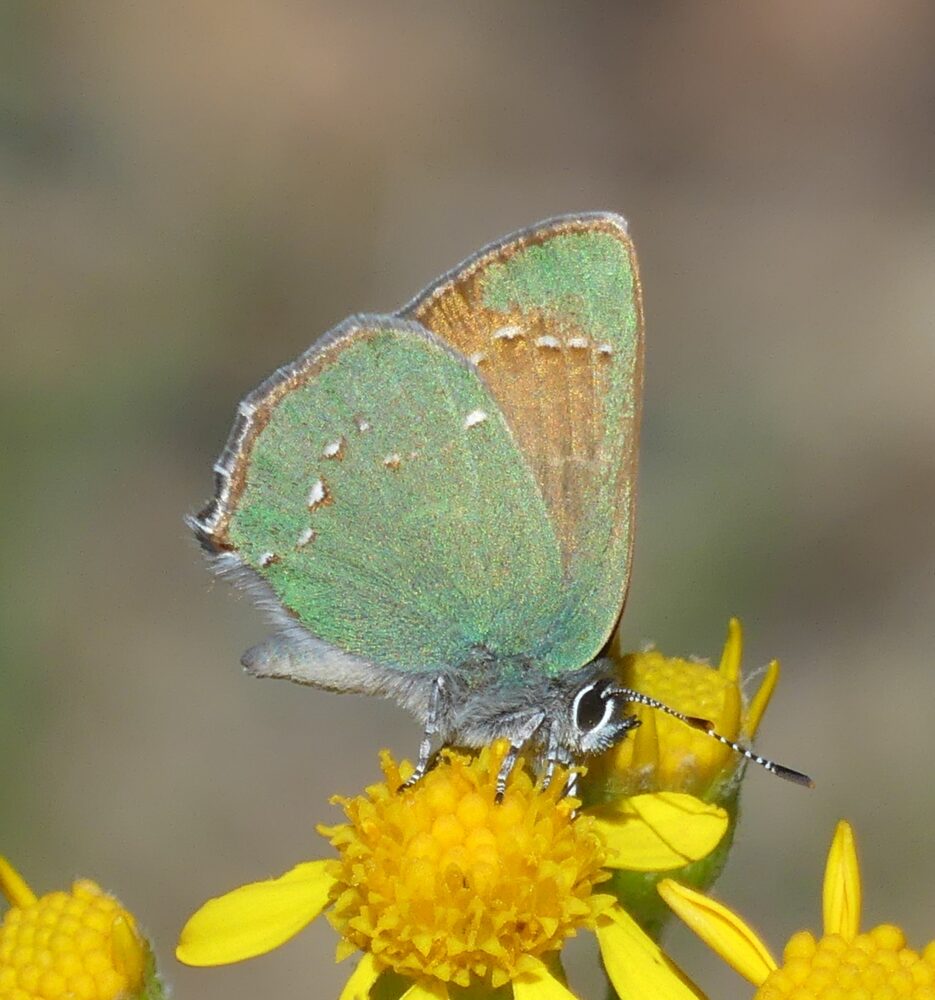
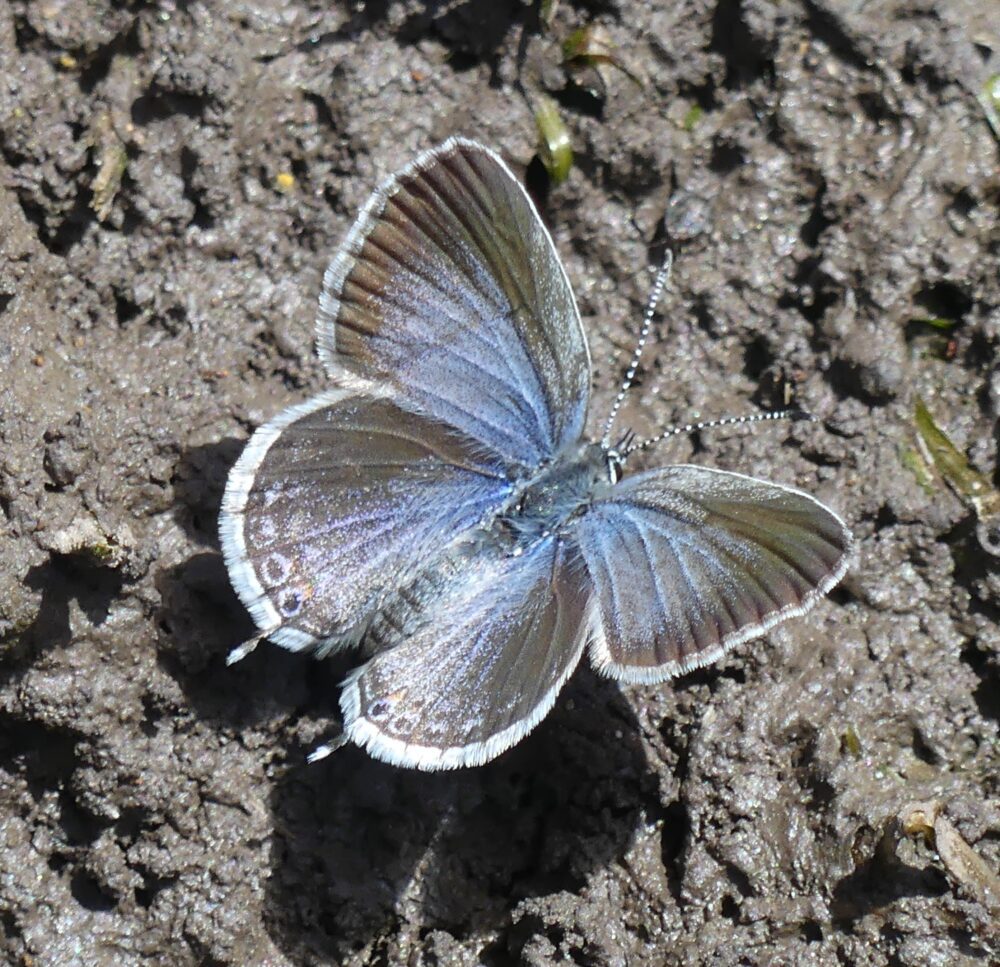
In early June, the search for Variable Checkerspots took me and Quin to the Chama area. I had seen Variable Checkerspot at Humphries Wildlife Management Area on June 6, 2001. On that day it was sunny and hot. Over the course of 3.5 hours, I documented 32 butterfly species. So how did we do 24 years later? You guessed it – fewer than a dozen species in a landscape that was only thinly green: a couple each of Burgess’ Duskywing, Rocky Mountain Duskywing, and Two-tailed Swallowtail. There were several Colias sulphurs and a few Purplish Coppers, 2 Juniper Hairstreaks, 5 Melissa Blues, 1 Silvery Checkerspot and 2 California Tortoiseshells. Field Crescents won the day with about 25 individuals. Overall, a rather unimpressive showing, and no Variable Checkerspots, but typical of what I was coming to expect from drought-stressed landscapes in northern New Mexico.
On the return drive south, we stopped at Heron Lake State Park in an attempt to replicate my mid-June 2019 sighting of Variable Checkerspot in the Pygmy Forest on the rim above the Rio Chama Gorge. Not only did we not see any checkerspots, we tallied barely 4 species, with only Juniper Hairstreaks present in significant numbers.
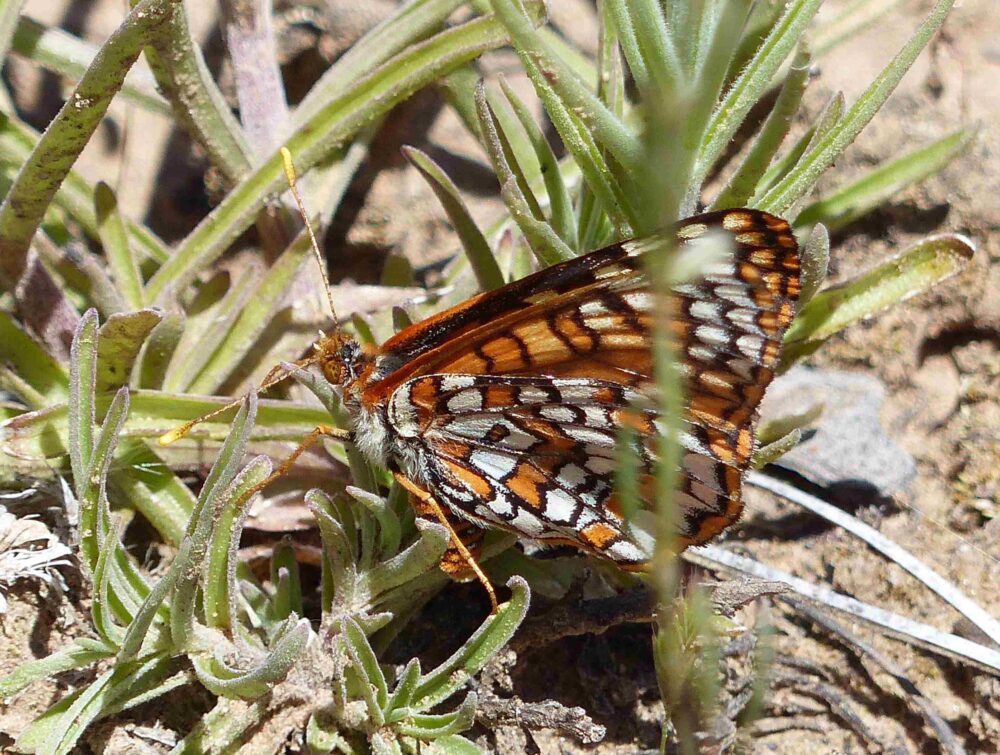
On June 8, Thomas Bulger and I drove east to the Canadian River near Mills, in Harding County. Thomas was keen to see some prairie/grassland butterflies and I was keen to get out of the dry mountains and out onto our Eastern Plains, where the US Drought Monitor indicated something closer to normal moisture conditions. Our drive east to Wagon Mound and then farther east into Harding County got progressively greener. There were flowers, and water in landscape depressions, and pronghorn on the prairies. We proceeded to some state trust land northeast of Mills. We parked, emerged from the car, and walked maybe a quarter mile to a low volcanic summit where we spotted our primary target, the Dotted Checkerspot. The whole way we remarked on how normal the landscape looked, smelled and sounded. It was very green, and plants seemed to be at normal heights and with normal flowers. Pollinators seemed a bit scarce, but Lark Buntings were plentiful and displaying all around us. We could smell the living grassland ecosystem, but butterflies were not part of the abundance. Setting aside the several Checkered Whites and several ordinary sulphurs, we saw one to a few of only 4 species. Lupine Blues won the morning with perhaps a half dozen mudding at edges of a brim-full cattle tank.
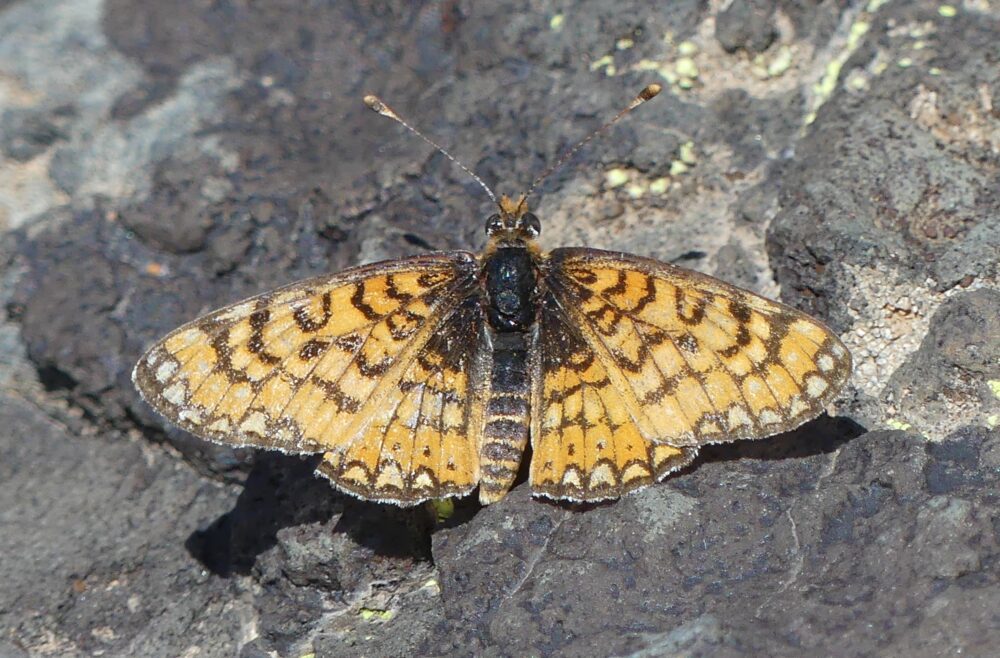
We progressed down into the Canadian River Canyon hoping for more, or different, species and we did add several to our day’s list: 3-4 Common Sootywings, 3-4 Uncas Skippers, 1-2 Two-tailed Swallowtails, several Juniper Hairstreaks, 1 Reakirt’s Blue, 1 Variegated Fritillary, and 1 Hackberry Emperor. Overall, on this hopeful day in a promising place we tallied 12 species. Butterflies (perhaps other insects, too) seemed to be lagging even in superficially lush conditions.
On June 12, Marcy and I, with Greg and Amy (and Chutney), drove up the Pecos River and parked at Cowles (~8000 ft). Our last few miles up the road were filled with Western Tiger Swallowtails . . . we may have seen 100 where road and river were close. My heart began to beat a little faster.

We then hiked a few miles on the Winsor Ridge Trail 271 (toward Stewart Lake) with Greg, Amy and Chutney. As the trail led uphill and away from the river, butterflies were scarcely to be seen. True, our 10:45 AM start meant we were hiking in the heat of the day, but we were in a diverse mosaic of pine/oak woodland with occasional grassy meadows. The forest was intensely verdant, with Gambel oaks, Fendler’s buckbrush and chokecherries wearing their vivid green, early summer foliage. Given those circumstances, one would expect a bunch of butterflies. But over four hours, and up to 9500 feet, all we saw were a couple of cloudywings, a couple of duskywings, 3 or 4 whites, 1 Western Tailed-blue, 1 Anise Swallowtail, 1 azure and 1 Blue Copper. No grass-skippers and no brushfoots. Also puzzling, there were almost no flowers. Blooming chokecherries were the exception, but there were almost zero pollinating insects available to visit them. This was underscored by the almost complete lack of bird song – the forest was eerily silent. Of course, with no insects to eat, the birds would have nested elsewhere.

That covers Rio Arriba, Harding and San Miguel counties, so let me close out this post by adding Santa Fe County, via notes from my June 13 hike on the Chamisa Trail up the hill from Santa Fe with Marcy, Trudy and Joe. We spent perhaps three hours on a morning hike to beat the heat. Any butterflies we saw would be extra fun. We did see a few: 2-3 cloudywings, 2-3 duskywings, 3-4 Western Tigers, 1 Pale Swallowtail, perhaps 10 Margined Whites, about 5 Western Pine Elfins, 2-3 Bramble Hairstreaks, 1 High Mountain Blue and about 15 Azures. The main attraction was a somewhat past-peak stand of Iris, right where the trail arrived at Big Tesuque Creek, our turn-around point. The two hairstreaks and high mountain blue were attempting to nectar there. Compared to my recollections, butterflies still seemed sparse, and the number of species still quite low. Again, no Hesperiine skippers and no brushfoots.
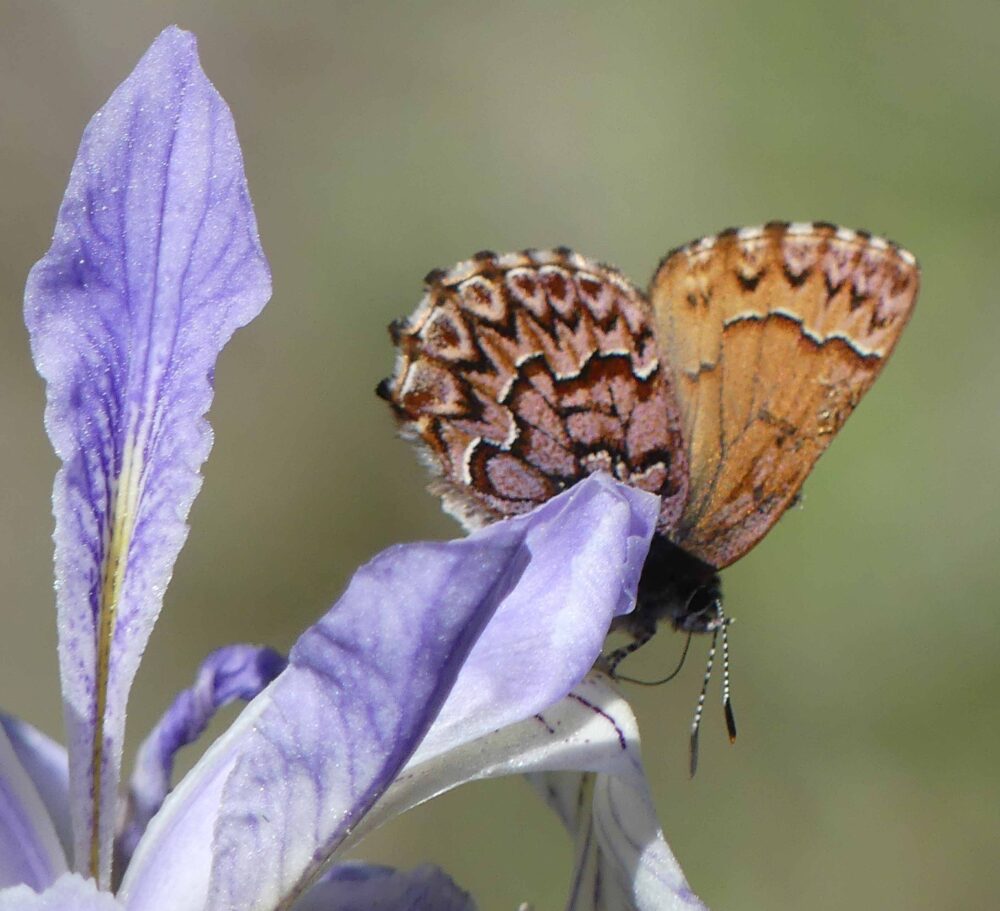
So, what does one make of these observations? I want to understand what is happening. Our warming, drying climate is posing challenges to our native butterfly species. “Butterflies” will not respond as a group, but as individual species. Each species has no choice but to respond/react as its life history circumstances dictate.
During May and early June, parts of northern New Mexico got significant if unseasonable rain (it’s our usual dry season!). We received almost 5 inches over 5 weeks at our house in Santa Fe. As a result, in many places the plant communities were responding with growth and flowers. But the next level up in food chains – insects – seemed to be lagging. That kind of makes sense because plants have roots in the ground and many can get into gear immediately. Insects, however, are at various stages in their complicated life cycles. Before adults can fly around to find mates and amuse butterflyers, eggs need to hatch, larvae need to eat, grow and pupate . . . each species on its own schedule. It may take weeks or months for some butterfly species to fulfill their potential and reveal themselves to us, simply following through on that May wet spell.
From my outings as described above, some of the observed butterflies, like Pine Elfin, Azures and Juniper Hairstreak, have host plants that are trees or shrubs, and therefore perhaps with extensive root systems, perhaps making them less dependent on normal moisture regimes. Western Tiger and Margined White each have creek-side hostplants, so also may be less vulnerable to drought. Not saying they are immune to drought, but perhaps less vulnerable than butterflies whose larvae eat dryland grasses and forbs, which have less chance of tapping reduced subsurface water or reduced soil moisture and may therefore remain dormant for long periods.
Some species (i.e., the ones we did not see) are responding by not flying. What options are available to them? Some may simply postpone adult emergence until later in the season. I noticed this many years ago with Boisduval’s Blue in the Sacramentos. Normally an early summer flyer, they and their host lupines showed no show signs of life until August, when summer rains finally pushed the right buttons for them. Sandia Hairstreak had a similar experience in the Sandia Mountains this spring. Winter moisture was weak, so their normal March flight showed low numbers, presumably because most pupae chose to remain pupae and wait until next year. But then inches of rain fell in May, and soon there were Sandia Hairstreaks all over the place well into June, much later than normal. This can be interpreted as a surprising second flight in a what we normally consider a single-brooded insect. This kind of flexibility, perhaps hidden to us, could pay off in the long run for many species.
Some butterflies have the capability to remain in diapause (dormant) for extended periods, even years. We know this is true for desert dwellers, like yucca moths. We know it is true for orangetips. Most species have not been tested, but maybe that should become a research priority as we continue forward into the climate unknown. Of those butterflies we are not seeing, I don’t believe we have lost any to extinction, yet (with possible exception of Sacramento Mountains Checkerspot). If they are not extinct, their abilities to get into and out of diapause may be one of the keys to their continued persistence.
In these stressful times, your observations are more valuable than ever. When you post photos and observations to BAMONA, iNaturalist or BugGuide, you provide information that can help researchers learn which species are thriving and which are not, and where, and why.

I am seeing very few butterflies at home in Albuquerque and in other places I’ve hiked this spring in New Mexico and Colorado. Places that look like they should be loaded with butterflies have few, like flowering meadows that have no pollinators or just one species.
Hi Stephanie, very nice to hear from you. I hope all we are seeing is simply a lag in production. first plants, but eventually insects will respond to precipitation. fingers crossed.
Thanks for your report, Steve. Western tiger swallowtails are also present in the Black Range, the Rim Trail near Sunspot, and along the Rio Penasco. We’ve finally gotten rain in Dona Ana County – hopefully everything gets rejuvenated this summer into early fall.
Gordon, thanks for expanding your search radius to include the Sacramentos. we need eyes on lots many species in there!
Surprised to find rhesus “swarming” in late May along Greens Peak Rd. W of Springerville, AZ. Checked the Quemado, NM spot in early June but bleak, not a single thistle! Very little but Nais Metalmark and Taxiles Skipper coming to Ceanothus today in Catalina Mts.
Ken Kertell
Tucson
Hi ken,
western NM continues to be very dry this season. eastern NM is getting early monsoons, but I hope they reach west pretty soon. thanks for reading and commenting!
Steve, we’ve been seeing a few different swallowtail species here in Rancho Viejo South
and we finally have a decent pollinator garden going. Always hoping for a Monarch, but probably too early for that. Thanks so much for your blog!
Sunnie and Joe
Hi Sunnie and Joe! great to hear from you. I bet your garden is terrific. I bet monarchs will find it in July (2nd brood). Thanks for reading and commenting!
Thanks, Steve, for your wonderful and detailed reporting from ‘up north’; kind of envious of your success! In Dona Ana County, my best field days have been in the 1-5 observed species (mostly blues and whites) range until this week when 10 species occurred along the Rio Grande on the 22nd. Of these, Lyside Sulphurs were most notable with 3 individuals and it’s been a while since I’ve observed American Ladies (2 individuals). In the past 2-3 days we’ve received nearly an inch of precipitation (much more in some spots) so our fortunes should change…
Hi Jim, your thoughts and observations are always appreciated. I do hope your recent rains change things for the better, but it may take a couple weeks.
Love reading of your successes and disapointments up north. Because of the rain this last week I hope to see some luck down south. Thanks for all you do!
Marcia, it is great to hear from you! Fingers crossed for improved conditions down in the desert!!